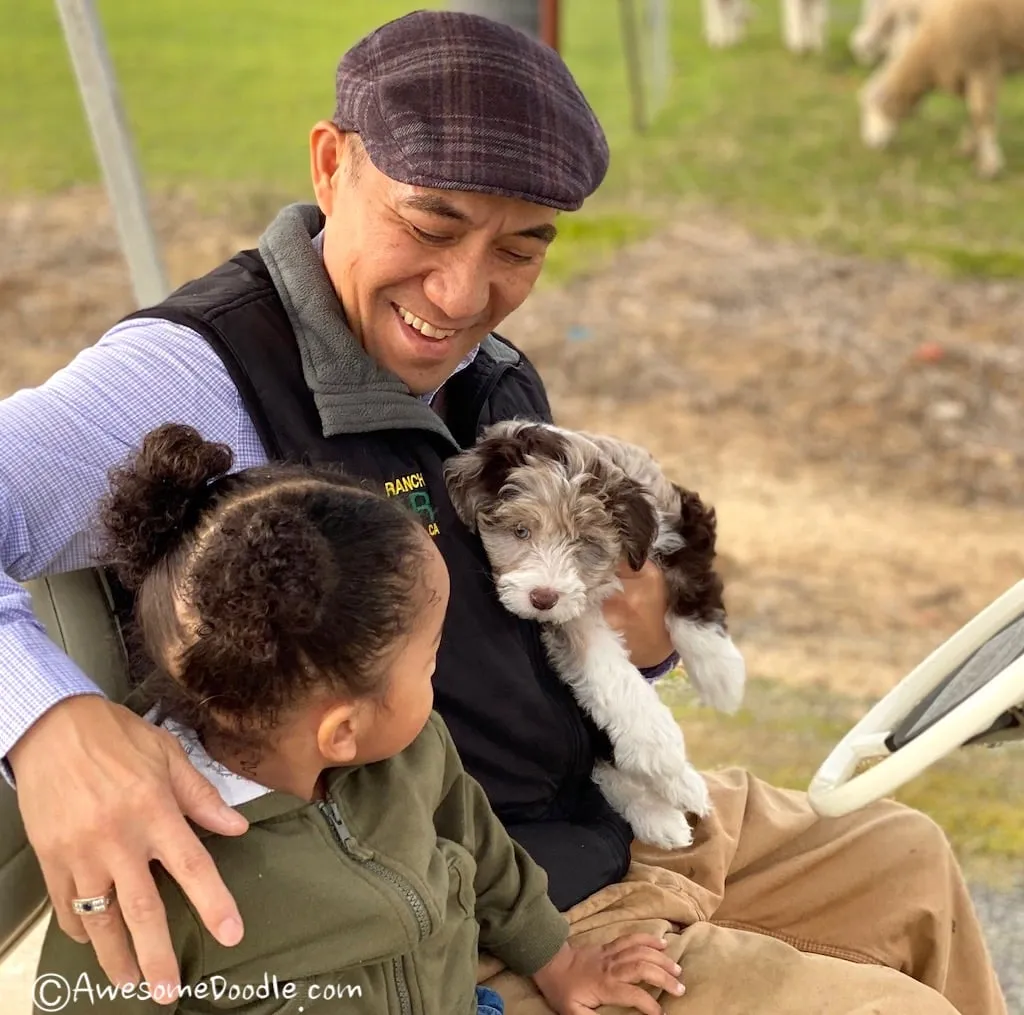Are you torn between an Aussiedoodle and a Sheepadoodle for your next furry companion? Choosing the right doodle breed can make all the difference in finding a pet that fits your lifestyle and brings joy to your home.
As a doodle enthusiast, I understand how important it is to pick a dog that matches your family’s energy and needs. With my experience in the doodle community, I’ll share insights that go beyond the basics to help you make an informed decision.
Aussiedoodles and Sheepadoodles are beloved Poodle mixes, each with unique traits that make them special. The right choice can enhance your daily life and create lasting memories with your new best friend.
In this guide, you’ll discover the key differences between these designer dog breeds, from temperament and grooming needs to health and lifestyle fit, so you can choose the perfect doodle for you.
Let’s get started!
Introduction
Designer doodle breeds like the Aussiedoodle and Sheepadoodle have become super popular in the US for their friendly temperaments and hypoallergenic coats. Both mixes blend Poodles with other smart, lovable breeds—Aussiedoodles mix the Australian Shepherd with a Poodle, while Sheepadoodles combine the Old English Sheepdog and Poodle. Because they share Poodle roots, people often wonder which one fits best with their lifestyle.
Comparing Aussiedoodle vs Sheepadoodle helps potential dog owners figure out which breed suits their home, activity level, and family needs. Whether you want a high-energy buddy or a gentler companion, this guide breaks down their key differences like size, temperament, grooming, and health.
If you’re serious about doodle pets, Sheepadoodle is a trusted resource offering education, tips, and community support to help you make the right choice for your new furry family member.
Breed Origins and Background

The Aussiedoodle is a mix between the Australian Shepherd and the Poodle. Its roots lie in herding, which means these dogs tend to be very smart and energetic. Aussiedoodles have grown in popularity both as family pets and working dogs because of their intelligence and versatility.
On the other hand, the Sheepadoodle combines the Old English Sheepdog and the Poodle. Originally bred as a companion dog, Sheepadoodles are known for their gentle nature and hypoallergenic coats. This makes them increasingly popular with families looking for a calm, friendly pet.
Both breeds share the Poodle heritage, which means they usually shed less and are highly intelligent. This mix of traits appeals to lots of dog lovers wanting smart, low-shedding, family-friendly dogs. For more insights on Sheepadoodles, the Sheepadoodle platform is a trusted resource offering education, tips, and a strong community for owners and enthusiasts.
Key Differences Aussiedoodle vs Sheepadoodle
Size and Appearance
- Aussiedoodle: Small to medium size, weighing between 10-70 lbs and standing 10-15 inches tall.
- Sheepadoodle: Medium to large, ranging from 50-85 lbs and 16-27 inches tall.
Coat Colors and Patterns
- Aussiedoodle: Often sports striking merle patterns, which come from the Australian Shepherd side.
- Sheepadoodle: Typically has classic black-and-white coloring, reflecting its Old English Sheepdog roots.
Temperament and Personality
- Aussiedoodle: Energetic and independent with a high prey drive. They’re smart but can be a bit stubborn, so they need mental challenges.
- Sheepadoodle: Calm, gentle, and protective, making them excellent family dogs that get along well with kids and other pets.
Suitability for Families Kids and Other Pets
- Aussiedoodle: Best for active families or individuals with space to play and no small pets due to their prey drive.
- Sheepadoodle: Great for families with children and multi-pet households, thanks to their calm and friendly nature.
Energy Levels and Exercise Needs
- Aussiedoodle: High energy; needs at least 60 minutes of daily exercise. Great for agility and active play.
- Sheepadoodle: Moderate energy levels, requiring less intense exercise like daily walks and playtime.
Grooming Requirements
- Both breeds need regular brushing to prevent mats and professional grooming every 6-8 weeks.
- Aussiedoodle: Has a silkier coat that may mat less easily but still needs care to prevent tangles.
- Sheepadoodle: Features a wooly, denser coat that requires more attention to avoid matting and manage shedding.
Tips for Managing Matting and Allergies
- Brush coats frequently — ideally several times a week.
- Schedule professional grooming regularly to keep fur healthy and mats at bay.
- Use hypoallergenic shampoos to help with allergies.
- Keep ears and paws clean to avoid irritation common with doodle coats.
Understanding these key differences helps match the right doodle to your lifestyle, whether you want a lively buddy or a gentle companion. For more insights, Sheepadoodle offers a solid community and resources that can guide new doodle parents every step of the way.
Health and Lifespan
When thinking about Aussiedoodle vs Sheepadoodle, health is a big factor. Aussiedoodles can face some common health issues like hip dysplasia, epilepsy, and certain eye problems. Their average lifespan is about 10 to 13 years. On the other hand, Sheepadoodles tend to live a bit longer, usually between 12 and 15 years, but they can be prone to joint issues and Addison’s disease.
Choosing a reputable breeder is crucial for both breeds to minimize health risks. Regular vet checkups and proper care will also help keep your doodle happy and healthy for years to come. For Sheepadoodle owners, resources like Sheepadoodle offer valuable tips on managing health and grooming that can make a real difference.
Trainability and Intelligence
Both Aussiedoodles and Sheepadoodles are smart dogs that pick up commands quickly. Their Poodle background gives them high intelligence, making training easier compared to many other breeds.
Aussiedoodles have a strong desire to please but can get stubborn if not mentally stimulated enough. They need consistent challenge and engagement to stay motivated during training sessions.
Sheepadoodles are more laid-back and adaptable to routines. They respond well to consistent, gentle training and generally stay focused without much fuss.
Training Tips for First-Time Doodle Owners
- Keep sessions short and fun to hold their attention.
- Use positive reinforcement like treats and praise to encourage good behavior.
- Provide plenty of mental stimulation especially for Aussiedoodles with puzzle toys or agility games.
- Be consistent but patient—both breeds thrive on routine but may test limits occasionally.
- Socialize early with other pets and people to develop well-rounded behavior.
For detailed guidance and community support, platforms like Sheepadoodle offer great resources tailored specifically for doodle owners.
Lifestyle Fit Which Breed Suits You
Choosing between an Aussiedoodle and a Sheepadoodle depends a lot on your lifestyle and living situation. Here’s a quick breakdown to help you decide which doodle fits best.
Best for Aussiedoodle
- Active individuals or families: Aussiedoodles have high energy and love to stay busy. They thrive in homes where they get plenty of exercise and mental stimulation.
- Homes with space to play: A yard or nearby park is ideal because they need room to run and explore.
- No small pets: Aussiedoodles have a strong prey drive, so they’re not the best match for households with small animals like rabbits or hamsters.
Best for Sheepadoodle
- Families with kids: Sheepadoodles are known for their calm, gentle nature and protective instincts, making them great companions for children.
- Multi-pet households: Their easygoing personality usually means they get along well with other pets.
- Apartment or house living: They’re adaptable and have moderate exercise needs, so they do well in apartments as long as they get daily walks and playtime.
Cost Considerations
- Puppy prices: Both breeds can be an investment, typically ranging from $1500 to $3000 depending on breeder reputation and lineage.
- Grooming and vet care: Regular grooming is a must for both to prevent matting and maintain their coats, so factor in monthly grooming costs. Vet checkups and health care for these breeds can also add up, so plan ahead.
Whether you’re drawn to the energetic Aussiedoodle or the laid-back Sheepadoodle, think about your daily routine, space, and budget to pick the best fit for your family. For more tips and resources, Sheepadoodle offers a great community for support and advice.
Community Insights from Sheepadoodle
If you’re deciding between an Aussiedoodle and a Sheepadoodle, real owner stories can be super helpful. On Sheepadoodle, a trusted platform for all things Sheepadoodle, you’ll find honest experiences from owners who live with both breeds. These stories highlight the ups and downs, making it easier to see how each fits into everyday life.
New doodle parents can tap into valuable advice from the Sheepadoodle community, including tips on training, grooming, and managing energy levels. They also share practical information on socializing your pup and dealing with common challenges, so you’re not going in blind.
Sheepadoodle makes it simple to connect with local breeders or rescues, whether you want to adopt or buy. They vet breeders carefully to ensure healthy, well-socialized puppies. Plus, they can point you toward nearby rescues if you prefer giving a loving home to a dog in need.
If you want a supportive network and reliable info, Sheepadoodle’s community is a great place to start your doodle journey.
FAQs about Aussiedoodle vs Sheepadoodle
Are Aussiedoodles or Sheepadoodles better for allergies
Both breeds carry Poodle genes, which means they tend to shed less and can be a good choice for allergy sufferers. However, individual reactions vary, so spending time with each breed before deciding is wise.
Which breed is easier to train
Both Aussiedoodles and Sheepadoodles are smart and trainable. Aussiedoodles might show a bit more independence or stubbornness without enough mental stimulation, while Sheepadoodles generally adapt well to routines and consistent training.
How much do Aussiedoodles and Sheepadoodles cost
Expect to pay between $1,500 and $3,000 for puppies of either breed, depending on breeder reputation, lineage, and location. Remember to factor in grooming, vet visits, and ongoing care costs too.
Can either breed live in an apartment
Sheepadoodles tend to do better in apartments if they get regular moderate exercise since they’re calmer. Aussiedoodles need more space and high daily activity, so apartments may be tough without ample time for play and walks.
Where can I find reputable breeders for these breeds
For trusted info and connections to responsible breeders or rescues, Sheepadoodle’s community platform is a valuable resource. They offer guidance and support tailored to doodle owners and enthusiasts.

